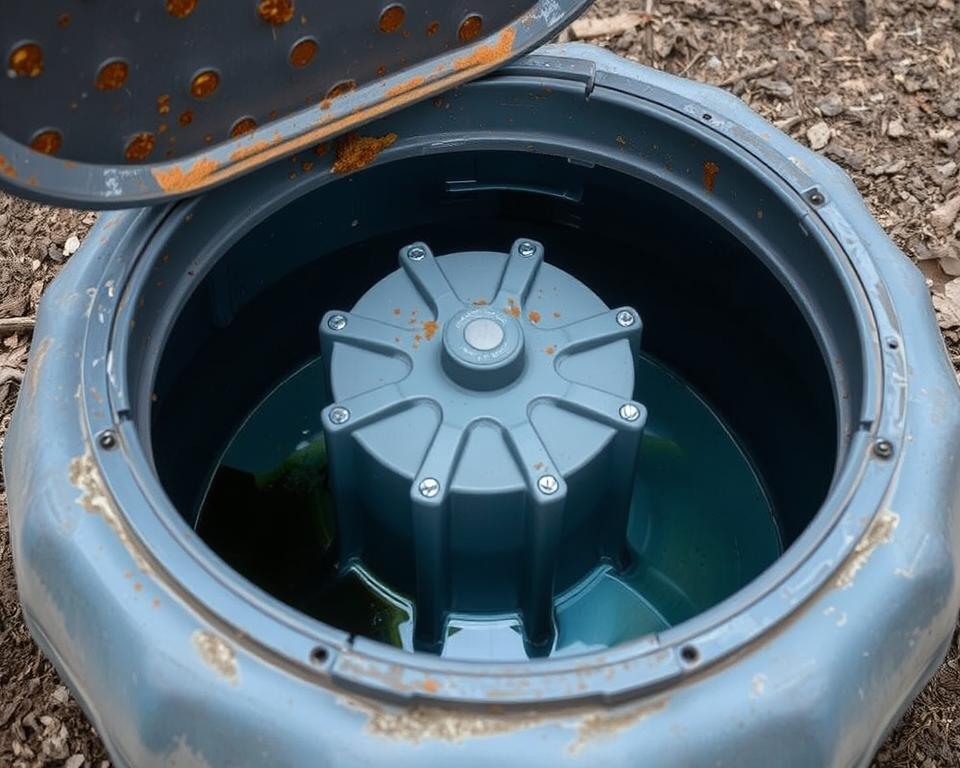Septic Tank Pumping Fees
Have you thought about the actual price of up‑keeping your septic system in good order, or if you’re shelling out too much? It’s essential for property owners to grasp the details of septic tank pumping prices. On average, the price tag hovers around $420, though it can vary considerably. This variance stems from elements like your system’s capacity and your location – septic inspection.
Routine maintenance of your septic tank prevents hefty fixes, underscoring the importance of knowing service costs. Our goal is to dive into septic tank service pricing comprehensively. This will help you plan cost‑effectively for your system’s care.
Main Takeaways
- Average septic tank pumping costs about $420.
- Prices can fall between $290 and $560 USD subject to various factors.
- Regular upkeep prevents larger repairs later on.
- Most households need pumping every three to five years.
- Household size and consumption can affect pumping frequency.
Recognizing the Value of Septic Tank Pumping
Septic tank pumping is crucial for a efficient wastewater system. It removes solids that, if left unchecked, lead to backups. Consistent pumping also prevents bad smells but also sidesteps steep repair costs.
Neglecting septic tank maintenance can jeopardize our wide use on these systems. Fortunately, reasonably priced services reduce the risk of system failure. Scheduled upkeep prolongs your septic system’s life, guaranteeing trouble‑free operation.
Cost data for septic tank upkeep illustrates the value of preventive care. Regular service detects problems at an initial stage, dodging severe damage and high repair bills. Regular pumping is a prudent move for homeowners to safeguard their property and enjoy peace of mind.
Typical Prices for Septic Tank Pumping
Septic tank pumping commonly falls between $250 and $600 in cost. In most cases, homeowners will spend about $400 for this critical service. Price variations are driven by variables like tank size, property location, and how often service is done. Standard tanks, around 1,000 gallons, usually cost between $225 and $400 USD.
Homeowners should remember the necessity of budgeting funds every 3 to 5 years for septic tank pumping. This scheduled care relies on the system load and size. It avoids bigger, pricier issues down the road, showing to be both time and cost‑effective.

Factors Influencing Septic Tank Pumping Prices
Several considerations are important in determining the cost of septic tank pumping. Understanding these details empowers homeowners to plan for these necessary services effectively.
The volume is significant a lot. Larger tanks require more effort and resources to empty, which means higher fees. The accessibility to your tank also greatly affects the price. Tanks installed deeply or in hard‑to‑reach locations demand more hours and extra gear from technicians, thus raising the labor costs.
Costs can vary widely based on where you live. This is due to variations in local labor rates and disposal fees. For example, some areas impose higher charges for getting rid of waste, affecting the total service cost. Moreover, tanks with significant solid waste accumulation also incur additional fees—anywhere from $100 to $300. Plus, the more frequently a tank requires pumping—due to higher water usage—the higher the ongoing expenses.
Septic Tank Capacity and Its Effect on Cost
The size of your septic tank directly impacts the cost of its upkeep. Lower‑capacity tanks, for example, those that can hold three‑quarters of a thousand gallons, typically have lower pumping costs, generally ranging from $175 USD to $300 USD. On the other hand, higher‑capacity tanks, capable of holding up to 1,750 gallons, may incur charges between $400 and $700. The majority of single‑family residences have tanks that hold between 1,000 to 1,250 gallons, delivering a mix between volume and performance.
Households with smaller tanks or many residents often require more frequent pumping services, which increases the overall expense. It’s important to arrange regular septic tank inspections in these situations. This makes sure the tank does not overflow or fail, which prevents additional damages. By comprehending the link between tank size and service fees, homeowners can take well‑informed choices regarding their septic systems and their upkeep demands.
Regional Differences in Septic Tank Pumping Costs
Septic tank pumping costs can differ substantially based on area. In urban areas, the expenses are frequently higher due to local septic services facing increased overhead. For example, Minneapolis, MN residents may spend between $180 USD and $280, while those in Portland, OR could see prices from $440 USD to $750.
The reasons behind these gaps are many. They include local living costs, demand for septic specialists, and regional regulations. In places where septic services are in short supply, homeowners might pay more due to the fewer choices. Moreover, strict regulations in some regions can increase the need for higher compliance fees, affecting the cost of services.
Understanding about these geographic cost variances is crucial for homeowners. It enables them to budget their septic maintenance budget more precisely. By recognizing local pricing, they can obtain quotes from specialists wisely, maintaining their septic system properly without financial strain.
Extra Expenses to Consider with Septic Tank Pumping
Homeowners often fail to consider various additional maintenance costs linked to septic tank pumping. The core cost includes just the standard service, not covering other potential expenses. Being aware of these can aid in preparing a comprehensive budget.
CCTV inspections, for instance, fall between $250 to $500. They offer a no‑dig look into the system’s condition. Additionally, filter maintenance, which if ignored can cause system failures, represents another cost.
The range for repairs can be large, from $100 to $4,000, depending on the specific issues. This spread underscores the need of factoring in additional maintenance costs for future budgeting.
Allocating Funds for Septic Tank Maintenance
When planning for septic tank care, it’s critical to adopt a comprehensive view. This includes a few critical elements. Owing to variable factors, the cost of maintenance can vary considerably. Because of this, proper financial planning is key.
To keep your system operates smoothly and to dodge surprise bills, keep these periods and services in mind:
- Scheduled pumping: This service is generally required every three to five years.
- Inspections: Plan for around $250 to $1,180 for inspections every three years.
- Potential repairs: Maintain a fund for unexpected fixes, which can pop up unexpectedly.
Creating a regular maintenance calendar with a reliable septic service is key. By expecting these expenses, homeowners can sidestep the steep costs tied to neglect. This approach ensures the longevity and effectiveness of their septic systems.
Common Signs That Your Septic Tank Needs Pumping
Staying alert to your septic system’s condition is vital. Spot the early signs that suggest your septic tank is due for pumping. Doing so can avoid significant damage and cut repair costs.
- Slow drains: Water that drains slowly in sinks, tubs, or toilets could indicate your septic tank is overflowing.
- Unpleasant odors: Bad smells near the septic tank or in your yard are frequently clear indicators of a problem.
- Gurgling sounds: Odd gurgling from your plumbing might indicate air is trapped because of a blockage.
- Wet spots: Puddles or lush grass patches near the drain field point to waste seepage from the tank.
- Dark green grass: Grass that is more vibrant and appears robust around the drain field may point out leakage of nutrients, suggesting an issue.
Scheduled checks by septic system specialists can keep your tank is in proper order. Relying on skilled septic technicians for maintenance stops these issues, supporting your system’s longevity.
Advantages of Regular Septic Tank Inspections
Scheduled inspections are central to preserving your septic system in prime shape. They identify potential problems before they grow into costly repairs. By engaging professionals for these checks, every part of your system undergoes a thorough assessment.
The inspection examines various parts of your system, including waste levels and the drain field’s condition. It verifies that critical parts, like baffles, operate as they should. Catching issues sooner helps prevent harmful overflows and shields the environment, benefiting both your home and the wider community.
Scheduling your septic tank inspected every three years can reduce a lot of money. It stops bigger issues from arising due to neglect. This not only cuts on repair costs but also secures your peace of mind.
| Inspection Aspect | Importance |
|---|---|
| Waste Level Assessment | Prevents overflow and backups |
| Drain Field Evaluation | Identifies saturation and function |
| Component Functionality Check | Ensures proper system operation |
| Early Problem Detection | Saves on repair costs |
Strategies to Save on Septic Tank Pumping Prices
Homeowners trying to reduce septic tank pumping costs have a few strategic options. Organizing group services with neighbors is one effective method. This involves working together with others nearby to request services collectively, potentially securing group discounts. It’s a way to strengthen community bonds while controlling expenses more economically.
Another helpful approach is to sign up for maintenance plans with septic service providers. These plans often include discounted prices for scheduled check‑ups and pumpings, ensuring septic systems working properly at a lower cost. Homeowners are advised to ask about these plans when contacting service companies.
Keeping the septic tank accessible can also shave pumping expenses. Simple accessibility means there’s no need for extra labor charges. It’s smart to keep the area around the tank free from obstructions, permitting straightforward servicing.
Adopting certain habits helps in prolonging the time between pumpings as well. Cutting back on water usage and curbing garbage disposal use are key practices. These actions can significantly improve septic system health, reducing the need for regular maintenance. By implementing these habits, homeowners can efficiently trim their septic tank pumping costs, protecting their finances and systems.
As a Final Point
Guaranteeing consistent septic tank pumping is essential for homeowners who want to keep their waste management system healthy and efficient. Being informed about the costs involved permits smart budgeting. This way, you can get cost‑effective septic services without compromising your system’s functionality.
Taking a preventive approach to maintenance is very beneficial. By noticing signs that show the need for pumping, you can avoid hefty repairs and prolong your system’s lifespan. Such actions not only improve your home’s functionality but also deliver you peace of mind.
Ultimately, maintaining regular inspections and timely septic tank pumping is vital for efficient home maintenance. By giving importance to proper planning and choosing affordable septic service, you’ll guarantee your septic system remains operational and effective for many years.

